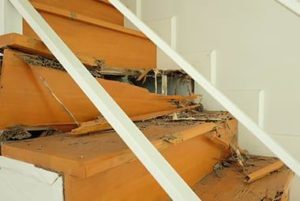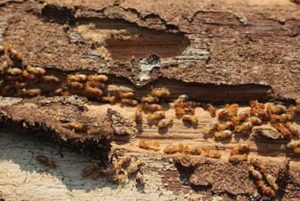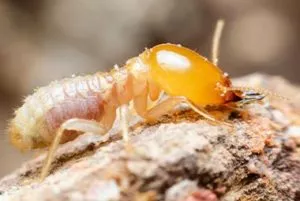In one of our last articles, we put out a warning because termite swarms are happening all over East Tennessee. If you have already seen a swarm at your home or found the cast off wings that indicate you missed a swarm nearby, you should contact an exterminator (like Russell’s Pest Control) for an inspection immediately. After all, termite colonies typically only produce swarms after they have already been breeding and feeding for about three years. If you’re seeing them above ground, they’ve already got the jump on you.
This time, however, I thought it might be important to cover the basics of termite biology so that you can recognize and understand these little critters if you encounter them. Termite identification is important so that you can be sure you know which enemy you’re facing and can act accordingly. First off, you should know that, unlike other wood-destroying insects, termites actually use their powerful jaws to eat the wood that they encounter instead of just tunneling through it. They are able to do so because tiny, single-celled creatures in their stomachs convert the wood particles from cellulose (which is indigestible) to starch. The term “starch” should ring a bell for you; we eat that, too, in foods like bread and pasta. Termites then convert that starch into their functional energy source: sugar. Combine this with the realization that termites work without sleeping, and they start to sound fairly alarming. They’re working 24 hours a day to sustain a life-long sugar high. Yikes!
So, how will you know them if you see them? Please refer to the photo below while we cover the basics of a termite’s appearance by comparing it to a very familiar spring-time bug: the ant. As you can see, termites are somewhat similar to ants, and swarming ants and termites are often mistaken for each other. The key differences between ants and termites are highlighted below.
- Waist Size: The tiny, pinched waist of the ant gives it a slightly waspish appearance; termites, however, are almost the same width all the way down their bodies. This shape and the dirty whitish color of the workers give them an almost grub-like appearance.
- Antennae Shape: Ants have long, thin antennae that bend like an elbow joint after leaving their heads. Termites have shorter antennae that do not bend at all.
- Wing Shape: This factor is particularly crucial for identification during swarm season since swarming termites are darker in color than the workers and are more likely to have an ant-like look about them. Ants have two pairs of wings of different shapes, and the front pair is noticeably larger than the back pair. Termites also have two pairs of wings, but all four wings are the same shape and size.
If you encounter insects like these around your home, you can use these features and this picture to try your hand at termite identification. Of course, you can call Russell’s Pest Control at 865.584.8549 for a free termite inspection if you want an expert’s opinion on the subject.
Just in case you suspect a termite problem and are worried about the cost of a treatment, we’ve got good news for you. If you call and mention this blog post, you can receive $100 off the installation of an Always Active Sentricon® Termite Colony Elimination System.* In our opinion, this is the best termite treatment available, and we stand by it with our 100% damage repair guarantee. If termites get past our defenses while your home is protected by this system, we’ll handle 100% of the needed repairs. Naturally, this discount can’t be combined with any other coupons or offers. Give us a call or contact us online if you want more details.
*Trademark Dow AgroSciences
A Lesson In Termite Identification And Biology in Knoxville TN
Serving East Tennessee since 1971


